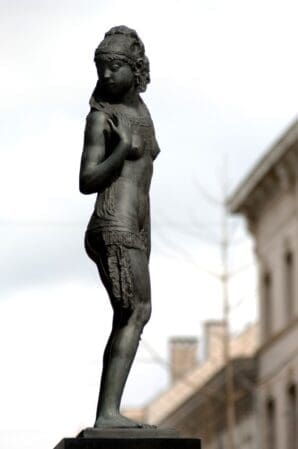BACCHANTE (ERNEST WIJNANTS)
Bacchante’: in Greek and Roman mythology she is a devotee of Dionysos-Bacchus, God of wine. This standing figure in bronze dates from 1928 and was purchased in 1931 by the Koninklijke Musea voor Schone Kunsten van België (Royal Museums of Fine Arts of Belgium) and is also on show there. Especially in the hairstyle one recognises the woodcarver’s hand applying small decorations and details, as if handling the chisel.
From a very young age Ernest Wijnants shows his talent as a wood carver while working in the furniture industry. At the age of twenty-one he already is a foreman. He befriends Rik Wouters, who is a fellow townsman, sculptor and painter. He paints in the impressionist tradition with, from time to time, a hint of Fauvism. In 1917 he reverts to sculpting.
His entire oeuvre as a sculptor is a tribute to woman, either in the nude or covered by a light gown. In his sculptural quest he aims to understand the spirit of woman. He sings the praise of her slenderness, sensuality, wealth, fertility. He cares less about detail than aesthetic design in a sculpture. Sometimes his work, especially his early work, has an air of exoticism. This exoticism is only noticeable in the decorative elements: a specific hairdo or an oriental style jewel. In his later works he rather emphasizes stylization.
WIJNANTS Ernest (1878-1964)
Ernest Wijnants was a wood carver in the furniture industry in Mechelen, he also was sculptor and painter. He got his education at the Academy of Mechelen and from 1906 onwards in Brussels. His first individual exhibition took pace in 1911 in Brussel. He was nominated teacher at the Academy for Fine Arts of Antwerpen in 1926 and was a teacher at the National Higher institute for Fine Arts in Antwerpen from 1931 onwards. He got several awards, amongst others: the ‘Prijs Edmond Picard’ (1926) the ‘Grote Prijs der Plastische Kunsten’ (1938). He designed the Belgian one franc coin in 1936, which remained in circulation until 1952. Wijnants was a member of the Royal Flemish Academy for Science, Literature and Fine Arts (1938) and his work was frequently exhibited in Belgium and abroad.
Kunst in de Stad – June 15th 1991

